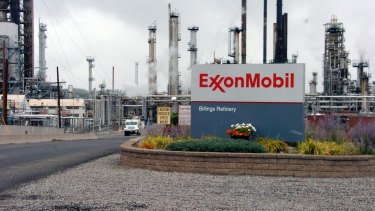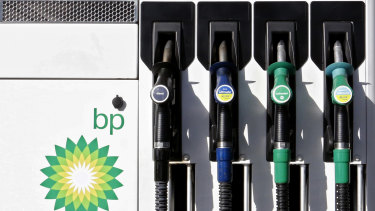Oil’s great divide: US, European giants at odds over the future
As oil prices plunge and concerns about climate change grow, BP, Royal Dutch Shell and other European energy companies are selling off oil fields, planning a sharp reduction in emissions and investing billions in renewable energy.
The American oil giants Chevron and Exxon Mobil are going in a far different direction. They are doubling down on oil and natural gas and investing what amounts to pocket change in innovative climate-oriented efforts like small nuclear power plants and devices that suck carbon out of the air.

The disparity reflects the vast differences in how Europe and the United States are approaching climate change, a global threat that many scientists say is increasing the frequency and severity of disasters like wildfires and hurricanes. European leaders have made tackling climate change a top priority while President Donald Trump has called it a “hoax” and has dismantled environmental regulations to encourage the exploitation of fossil fuels.
As world leaders struggle to adopt coordinated and effective climate policies, the choices made by oil companies, with their deep pockets, science prowess, experience in managing big engineering projects and lobbying muscle may be critical. What they do could help determine whether the world can meet the goals of the Paris agreement to limit the increase of global temperatures to below 3.6 degrees Fahrenheit above preindustrial levels.
The big American and European oil and gas companies publicly agree that climate change is a threat and that they must play a role in the kind of energy transition the world last saw during the industrial revolution. But the urgency with which the companies are planning to transform their businesses could not be more different.
“Despite rising emissions and societal demand for climate action, US oil majors are betting on a long-term future for oil and gas, while the European majors are gambling on a future as electricity providers,” said David Goldwyn, a top State Department energy official in the Obama administration. “The way the market reacts to their strategies and the 2020 election results will determine whether either strategy works.”
To environmentalists and even some Wall Street investors, the American oil giants are clearly making the wrong call. In August, for example, Storebrand Asset Management, Norway’s largest private money manager, divested from Exxon Mobil and Chevron. And Larry Fink, who leads the world’s largest investment manager, BlackRock, has called climate change “a defining factor in companies’ long-term prospects.”
European oil executives, by contrast, have said that the age of fossil fuels is dimming and that they are planning to leave many of their reserves buried forever. They also argue that they must protect their shareholders by preparing for a future in which governments enact tougher environmental policies.
BP is the standard-bearer for the hurry-up-and-change strategy. The company has announced that over the next decade it will increase investments in low-emission businesses tenfold, to $US5 billion ($6.9 billion) a year, while shrinking its oil and gas production by 40 per cent. Royal Dutch Shell, Eni of Italy, Total of France, Repsol of Spain and Equinor of Norway have set similar targets. Several of those companies have cut their dividends to invest in new energy.
American oil executives say it would be folly for them to switch to renewables, arguing that it is a low-profit business that utilities and alternative energy companies can pursue more effectively. They say it is only a matter of time before oil and gas prices recover as the pandemic recedes.

For now, Exxon and Chevron are sticking to what they know best, shale drilling in the Permian Basin of Texas and New Mexico, deepwater offshore production and trading natural gas. In fact, Chevron is acquiring a smaller oil company, Noble Energy, to increase its reserves.
“Our strategy is not to follow the Europeans,” said Daniel Droog, Chevron’s vice president for energy transition. “Our strategy is to decarbonise our existing assets in the most cost-effective way and consistently bring in new technology and new forms of energy. But we’re not asking our investors to sacrifice return or go forward with three decades of uncertainty on dividends.”
Chevron says it is increasing its own use of renewable energy to power its operations. It also says it is reducing emissions of methane, a powerful greenhouse gas. And the company has invested more than $US1.1 billion in various projects to capture and sequester carbon so it isn’t released into the atmosphere.
Its venture capital arm, Chevron Technology Ventures, is investing in new-energy startups like Zap Energy, which is developing modular fusion nuclear reactors that release no greenhouse gases and limit radioactive waste. Another, Carbon Engineering, removes carbon dioxide from the atmosphere to convert into fuel.
All told, Chevron Technology Ventures has two funds with a total of $US200 million, about 1 per cent of the company’s capital and exploration budget last year. The company has a separate $US100 million fund to support a $US1 billion investment consortium that aims to reduce emissions across the oil and gas industry.
“We need breakthrough technology and my job is to go find it,” said Barbara Burger, president of Chevron Technology Ventures, which employs 60 of Chevron’s 44,000 employees. “The transition is not an 11:59-on-Tuesday event. It’s going to be gradual, and evolving and continual over decades.”
Exxon has also largely steered away from renewables and has instead invested in roughly one-third of the world’s limited carbon-capture capacity, which has been so expensive and energy intensive that few companies have been willing to underwrite large-scale projects.
It spends about $US1 billion a year on research and development, much of which goes to developing new energy technologies and efficiency improvements that reduce emissions.
One project involves directing carbon emitted from industrial operations into a fuel cell that can generate power. That should reduce emissions while increasing energy production.
In a separate experiment, Exxon recently announced a “big advance” with scientists at University of California, Berkeley, and the Lawrence Berkeley National Laboratory for developing materials that help capture carbon dioxide from natural-gas power plants with less heating and cooling than previous methods.

Credit:AP
The company is also working on strains of algae whose oils can produce biofuel for trucks and airplanes. The plants also absorb carbon through photosynthesis, which Exxon scientists are trying to speed up while producing more oil.
“Step one, you have to do the science, and it is impossible to put a deadline on discovery,” said Vijay Swarup, Exxon’s vice president for research and development.
The New York Times
Market Recap
A concise wrap of the day on the markets, breaking business news and expert opinion delivered to your inbox each afternoon. Sign up for the Herald‘s here and The Age‘s here.
Most Viewed in Business
Source: Thanks smh.com